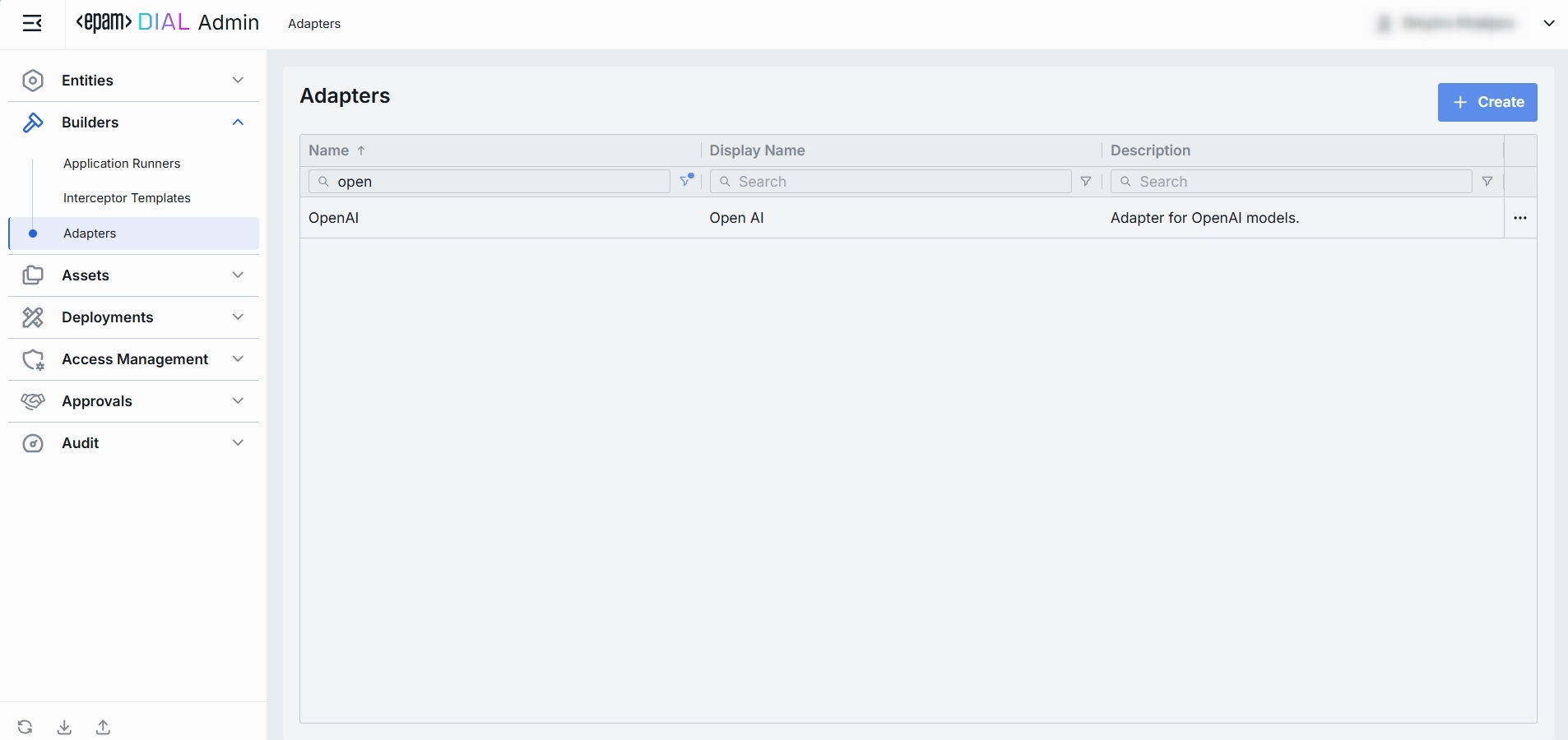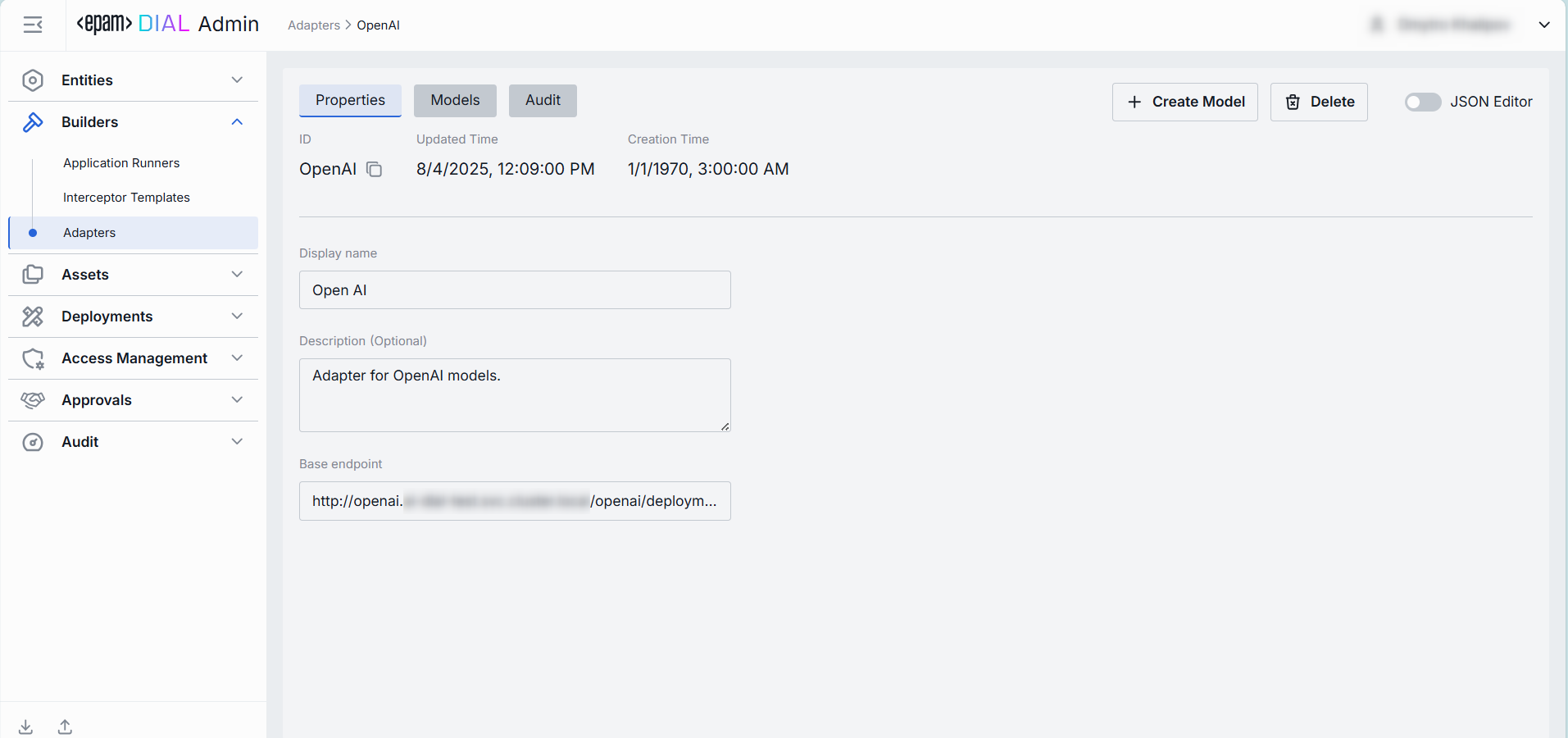Adapters
About Adapters
In DIAL, model adapters unify provider-specific model APIs with the Unified Protocol of DIAL Core. Each adapter consists of:
- Coded implementation that talks to the AI model and implements the Unified Protocol.
- Metadata object that you manage in Builders → Adapters, which establishes the relationship to the models.
Refer to Adapters documentation to learn more.
Adapters Main Screen
The main screen displays all registered adapters in your DIAL instance.

Adapters Grid
| Column | Definition |
|---|---|
| ID | The adapter’s unique name (identifier). |
| Display Name | A user-friendly label for the adapter. Helps you pick the right adapter when creating a new model. |
| Description | Free-text notes about the adapter’s purpose (e.g., “Adapter for OpenAI models”). |
| Updated time | Timestamp of the last update to this adapter's configuration. Useful to track recent changes. |
Create
On the main scree, you can add new adapters to your instance of DIAL:
-
Click + Create to invoke the Adapter modal.
-
Define key parameters for the new adapter:
Field Required Definition ID Yes A unique identifier for this adapter. Display name No A user-friendly name of the adapter. Description No Free-text notes about what this adapter is for. Base endpoint Yes The base URL of the adapter service that implements the Unified Protocol. Is the base URL part of the model completion endpoint if one created based on the adapter. -
Once all required fields are filled, click Create. The dialog closes and the new adapter's configuration screen is opened. A new adapter will appear immediately on the main screen once it is created.

Configuration
Click any adapter on the main screen to open its configuration page.
Top Bar Controls
- Create Model: Use to create a model deployment using the selected model adapter. Created models will be available in the Entities → Models section.
- Delete: Use to remove the adapter itself and all models utilizing it. After confirmation - the adapter and all related models are deleted.
- JSON Editor (Toggle): Switch between the form-based UI and raw JSON view of the adapter's configuration. Use JSON mode for copy-paste or advanced edits.
Properties
In the Properties tab, you can view and define identity and metadata of the selected adapter.
| Field | Required | Editable | Definition |
|---|---|---|---|
| ID | - | No | A unique identifier for this adapter. |
| Updated Time | - | No | Timestamp of the last update to this adapter's configuration. Useful to track recent changes. |
| Creation Time | - | No | Adapter creation timestamp. |
| Display name | Yes | Yes | A user-friendly name of the adapter. |
| Description | No | Yes | Free-text notes about what this adapter is for. |
| Base endpoint | Yes | Yes | The base URL of the adapter service that implements the Unified Protocol. Is the base URL part of the model completion endpoint if created based on the adapter. |

Models
In the Models tab, you can manage all models this adapter exposes.
| Column | Description |
|---|---|
| ID | Model's identifier. |
| Display Name | A user-friendly name of the model that will be displayed on UI. |
| Description | A free-text description of the model |

Add
You can add new models that will be processed by the selected adapter.
- Click + Add.
- Select one or more available models in the modal window. You can check all the available models in the Entities → Models section. You can also use + Create Model button on this screen to create a new model on the fly.
- Confirm to insert them into the table.
Remove
You can remove models processed by the adapter.
- Click the actions menu in the model’s line.
- Choose Remove in the menu.
Audit
In the Audit tab, you can monitor activities related to the selected adapter.
Activities
The Activities section provides detailed visibility into all changes made to the selected adapter. This section mimics the functionality available in the global Audit → Activities menu, but is scoped specifically to the selected adapter.
JSON Editor
For advanced scenarios of bulk updates, copy/paste between environments, or tweaking settings not exposed in the form UI—you can switch to the JSON Editor in any adapter's configuration page.
Switching to the JSON Editor
- Navigate to Builders → Adapters, then select the adapter you want to edit.
- Click the JSON Editor toggle (top-right). The UI reveals the raw JSON.
TIP: Switching modes is disabled if there are any unsaved changes.